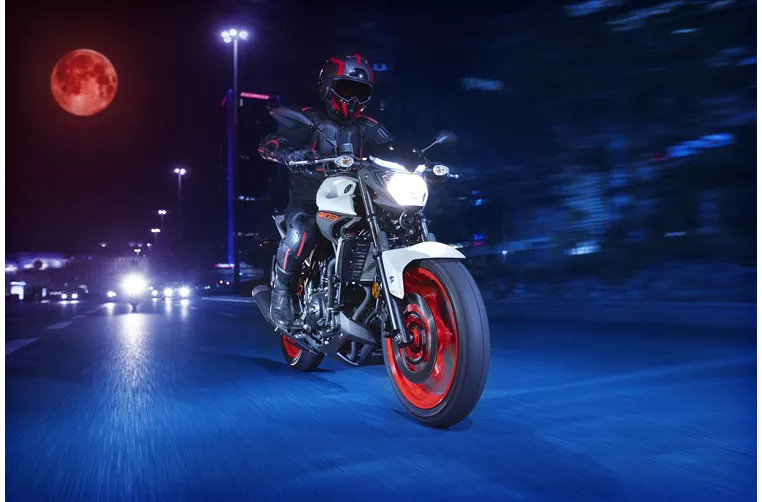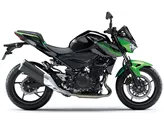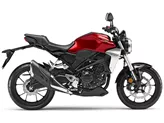Yamaha MT-03 2019 vs. Kawasaki Z 400 2019

Yamaha MT-03 2019

Kawasaki Z 400 2019
Overview - Yamaha MT-03 2019 vs Kawasaki Z 400 2019
The Yamaha MT-03 2019 and the Kawasaki Z 400 2019 are both naked bikes that offer a thrilling riding experience. While they have several similarities in terms of engine type, suspension, and frame, there are also some notable differences between the two models.
In terms of engine specifications, the Yamaha MT-03 2019 is equipped with an in-line, liquid-cooled engine with a displacement of 321cc. It produces 42 horsepower and 29.6 Nm of torque, making it a powerful option for riders. On the other hand, the Kawasaki Z 400 2019 features a slightly larger engine with a displacement of 399cc. It delivers 45 horsepower and 38 Nm of torque, providing a slightly higher power output than the Yamaha MT-03.
Both bikes come with a telescopic fork front suspension and a swing arm rear suspension with a monoshock absorber. This setup ensures a smooth and comfortable ride, absorbing bumps and providing stability on the road. The chassis of the Yamaha MT-03 2019 is made of steel and features a twin tube frame, while the Kawasaki Z 400 2019 has a steel frame with a tubular design. These chassis designs contribute to the overall stability and handling of the bikes.

Yamaha MT-03 2019
In terms of braking performance, both bikes are equipped with a single disk front brake. However, the Kawasaki Z 400 2019 has a larger front brake diameter of 310mm compared to the Yamaha MT-03 2019's 298mm. This larger brake diameter may provide slightly better stopping power for the Kawasaki Z 400.
Both the Yamaha MT-03 2019 and the Kawasaki Z 400 2019 come with ABS, which is an advanced rider assistance system that enhances safety by preventing wheel lock-up during braking. This feature is especially beneficial for novice riders who may not have as much experience with emergency braking situations.
When it comes to dimensions and weights, the Yamaha MT-03 2019 has a front tire width of 110mm and a rear tire width of 140mm, while the Kawasaki Z 400 2019 has a slightly wider rear tire width of 150mm. Both bikes have a wheelbase of around 1370-1380mm, providing stability and maneuverability. The seat height of the Yamaha MT-03 2019 is 780mm, while the Kawasaki Z 400 2019 has a slightly higher seat height of 785mm. The kerb weight of both bikes is relatively similar, with the Yamaha MT-03 2019 weighing 168kg and the Kawasaki Z 400 2019 weighing 167kg.

Kawasaki Z 400 2019
In terms of strengths, the Yamaha MT-03 2019 is praised for its well-controllable power, low seat height, easy rideability, low fuel consumption, easy-to-read LCD display, and aggressive look. On the other hand, the Kawasaki Z 400 2019 is commended for its great and very controllable power delivery, low weight, good seating position, great sound, and suitability for novice riders.
However, both bikes also have some weaknesses. The Yamaha MT-03 2019 may have a sharp knee angle for taller riders and a softer chassis compared to other Yamaha MT models. It is also considered to be less emotionally engaging compared to some other motorcycles. The Kawasaki Z 400 2019 has non-adjustable clutch and brake levers, which may limit customization options for riders. Additionally, the chassis of the Kawasaki Z 400 2019 is not as adjustable as some other models, which may limit the bike's adaptability to different riding styles.
In conclusion, the Yamaha MT-03 2019 and the Kawasaki Z 400 2019 are both powerful and capable naked bikes. While they share similarities in terms of engine type, suspension, and frame, they also have some differences in terms of power output, braking performance, and adjustability. Ultimately, the choice between the two models will depend on the rider's preferences and priorities.
Technical Specifications Yamaha MT-03 2019 compared to Kawasaki Z 400 2019
Pros and Cons in comparison
Pros and Cons in comparison
Yamaha MT-03 2019

The MT-03 remains Yamaha's most accessible and pragmatic Hyper Naked in the segment. It scores with its low seat height, the easily controllable power of the two-cylinder and at the same time offers enough comfort for commuters. What it may lack in sportiness, it makes up for in comfort, making it perfect for people looking for a well-functioning motorbike with a brutal look. However, you shouldn't be too big, and you shouldn't aspire to keep up with the other models in the MT range at the angle - because that's not what it was designed for. The 2020 model year is thus a coherent update that is sure to make its buyers happy.
Kawasaki Z 400 2019

The Kawasaki Z400 is definitely a great evolution of its predecessor, the Z300. More power, less weight - all around, simply an even better bike. Above all, the linear power delivery and excellent handling make the Z400 an ideal entry-level bike. The ease of clutch operation and good chassis set-up are also in this vein, which is why the Z400 can be recommended to novice riders without hesitation.
Price Comparison Avarage Market Price Yamaha MT-03 vs Kawasaki Z 400
There are a few key differences between a Yamaha MT-03 2019 and a Kawasaki Z 400 2019. It takes less time to sell a Yamaha MT-03 with 89 days compared to 99 days for a Kawasaki Z 400. Since model year 2006 1000PS.de editors have written 8 reviews for the Yamaha MT-03 and 8 reviews for the Kawasaki Z 400 since model year 2019. The first review for the Yamaha MT-03 was published on 12/15/2005 and now has more than 109,900 views. This compares to more than 23,200 views for the first review on Kawasaki Z 400 published on 10/2/2018.




















